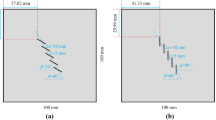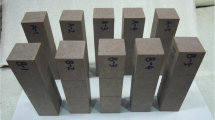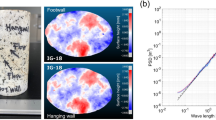Abstract
The distinction between the shear behavior of tensile- and shear-induced fractures is critical to understanding the deformation and failure of geologic discontinuities at different scales. To investigate these differences, a series of direct shear tests were performed on sandstone specimens with a continuous fracture created by either splitting or shearing. The acoustic emission (AE) technique was used to examine variations in grain-size cracking behavior between specimens with tensile- and shear-induced fractures. An increase in normal stress for both fracture types correlates with increased microcrack density and energy release. However, there are notable differences: during the shear process, tensile-induced fractures produce AE sequences similar to the seismic patterns observed along natural tectonic faults, with foreshocks, mainshocks, and aftershocks. In contrast, the AE sequence for shear-induced fractures during the shear process lacks prominent mainshocks and deviates progressively from the power-law function with time as normal stress increases. In addition, the AE b-value for tension-induced fractures initially shows a gradual decrease as the mainshock approaches and then slowly increases during the aftershock period. In contrast, the b-value remains nearly constant for shear-induced fractures due to the low roughness and heterogeneity of the fracture surface. These differences highlight the strong correlation between AE responses and fault heterogeneity, paving the way for fault characterization and risk assessment in subsurface energy extraction.
Highlights
-
The cracking behavior of both tensile- and shear-induced fractures in direct shear tests is investigated using the AE technique.
-
In direct shear tests, the AE sequences of tensile fractures follow a power law, while a significant deviation from the power law is observed in the AE sequence of shear fractures.
-
The power-law evolution of the AE sequence before and after the mainshock, together with anomalous b-values, can be used as indicators to distinguish young faults from mature faults.











Similar content being viewed by others
Data Availability
Data will be made available on request.
References
Amorèse D (2007) Applying a change-point detection method on frequency-magnitude distributions. Bull Seismol Soc Am 97(5):1742–1749
Badt N, Hatzor YH, Toussaint R, Sagy A (2016) Geometrical evolution of interlocked rough slip surfaces: the role of normal stress. Earth Planet Sci Lett 443:153–161
Beeler NM (2004) Review of the physical basis of laboratory-derived relations for brittle failure and their implications for earthquake occurrence and earthquake nucleation. Pure Appl Geophys. https://doi.org/10.1007/s00024-004-2536-z
Bolton DC, Shreedharan S, Riviere J, Marone C (2021) Frequency-magnitude statistics of laboratory foreshocks vary with shear velocity, fault slip rate, and shear stress. J Geophys Res Solid Earth 126(11):e2021JB022175
Bolton DC, Marone C, Saffer D, Trugman DT (2023) Foreshock properties illuminate nucleation processes of slow and fast laboratory earthquakes. Nat Commun 14(1):3859
Boneh Y, Chang JC, Lockner DA, Reches Z (2014) Evolution of wear and friction along experimental faults. Pure Appl Geophys 171(11):3125–3141
Borate P, Riviere J, Marone C, Mali A, Kifer D, Shokouhi P (2023) Using a physics-informed neural network and fault zone acoustic monitoring to predict lab earthquakes. Nat Commun 14(1):3693
Byerlee JD (1970) The mechanics of stick-slip. Tectonophysics 9(5):475–486
Cattania C, Segall P (2021) Precursory Slow Slip and foreshocks on rough faults. J Geophys Res: Solid Earth. https://doi.org/10.1029/2020JB020430
Chen B-R, Feng X-T, Li Q-P, Luo R-Z, Li S (2013) Rock burst intensity classification based on the radiated energy with damage intensity at **** II hydropower station, China. Rock Mech Rock Eng 48(1):289–303
Cui G, Zhang C, Ye J, Zhou H, Li L, Zhang L (2022) Influences of dynamic normal disturbance and initial shear stress on fault activation characteristics. Geomech Geophys Geo-Energy Geo-Resour. https://doi.org/10.1007/s40948-022-00463-6
Davidesko G, Sagy A, Hatzor YH (2014) Evolution of slip surface roughness through shear. Geophys Res Lett 41(5):1492–1498
Davidsen J, Stanchits S, Dresen G (2007) Scaling and universality in rock fracture. Phys Rev Lett 98(12):125502
Dresen G, Kwiatek G, Goebel T, Ben-Zion Y (2020) Seismic and aseismic preparatory processes before large stick-slip failure. Pure Appl Geophys 177(12):5741–5760
Einstein HH (2021) Fractures: tension and shear. Rock Mech Rock Eng 54(7):3389–3408
Freed AM (2005) Earthquake triggering by static, dynamic, and postseismic stress transfer. Annu Rev Earth Planet Sci 33(1):335–367
Geffers GM, Main IG, Naylor M (2022) Biases in estimating b-values from small earthquake catalogues: how high are high b-values? Geophys J Int 229(3):1840–1855
Goebel THW, Becker TW, Schorlemmer D, Stanchits S, Sammis C, Rybacki E, Dresen G (2012) Identifying fault heterogeneity through map** spatial anomalies in acoustic emission statistics. J Geophys Res Solid Earth. https://doi.org/10.1029/2011JB008763
Goebel THW, Sammis CG, Becker TW, Dresen G, Schorlemmer D (2013a) A comparison of seismicity characteristics and fault structure between stick-slip experiments and nature. Pure Appl Geophys 172(8):2247–2264
Goebel THW, Schorlemmer D, Becker TW, Dresen G, Sammis CG (2013b) Acoustic emissions document stress changes over many seismic cycles in stick-slip experiments. Geophys Res Lett 40(10):2049–2054
Goebel THW, Brodsky EE, Dresen G (2023) Fault roughness promotes earthquake-like aftershock clustering in the lab. Geophys Res Lett. https://doi.org/10.1029/2022GL101241
Grasselli G (2006) Manuel rocha medal recipient shear strength of rock joints based on quantified surface description. Rock Mech Rock Eng 39(4):295–314
Gu L, Hao S, Elsworth D (2023) Precursory predictors of the onset of stick-slip frictional instability. Int J Solids Struct 264:112119
Gutenberg B, Richter CF (1944) Frequency of earthquakes in California. Bull Seismol Soc Am 34:185–188
Hao S-W, Rong F, Ming-Fu L, Wang H-Y, **a M-F, Fu-Jiu K, Bai Y-L (2013) Power-law singularity as a possible catastrophe warning observed in rock experiments. Int J Rock Mech Min Sci 60:253–262
Hardebeck JL, Felzer KR, Michael AJ (2008) Improved tests reveal that the accelerating moment release hypothesis is statistically insignificant. J Geophys Res Solid Earth. https://doi.org/10.1029/2007JB005410
Hofmann H et al (2019) First field application of cyclic soft stimulation at the Pohang Enhanced Geothermal System site in Korea. Geophys J Int 217(2):926–949
Ji Y, Hofmann H, Duan K, Zang A (2022a) Laboratory experiments on fault behavior towards better understanding of injection-induced seismicity in geoenergy systems. Earth Sci Rev 226:103910
Ji Y, Wang L, Hofmann H, Kwiatek G, Dresen G (2022b) High-rate fluid injection reduces the nucleation length of laboratory earthquakes on critically stressed faults in granite. Geophys Res Lett. https://doi.org/10.1029/2022GL100418
Jiang Q, Yang B, Yan F, Liu C, Shi Y, Li L (2020) New method for characterizing the shear damage of natural rock joint based on 3D engraving and 3D scanning. Int J Geomech. https://doi.org/10.1061/(ASCE)GM.1943-5622.0001575
Johansson F (2016) Influence of scale and matedness on the peak shear strength of fresh, unweathered rock joints. Int J Rock Mech Min Sci 82:36–47
Karami A, Stead D (2007) Asperity degradation and damage in the direct shear test: a hybrid FEM/DEM approach. Rock Mech Rock Eng 41(2):229–266
Kim Y-S, Peacock DCP, Sanderson DJ (2003) Mesoscale strike-slip faults and damage zones at Marsalforn, Gozo Island, Malta. J Struct Geol 25(5):793–812
Kolawole F et al (2019) The susceptibility of Oklahoma’s basement to seismic reactivation. Nat Geosci 12(10):839–844
Lei X (2003) How do asperities fracture? An experimental study of unbroken asperities. Earth Planet Sci Lett 213(3–4):347–359
Lei X, Ma S (2014) Laboratory acoustic emission study for earthquake generation process. Earthq Sci 27(6):627–646
Lei X et al (2004) Detailed analysis of acoustic emission activity during catastrophic fracture of faults in rock. J Struct Geol 26(2):247–258
Li B, Jiang Y, Mizokami T, Ikusada K, Mitani Y (2014) Anisotropic shear behavior of closely jointed rock masses. Int J Rock Mech Min Sci 71:258–271
Li Y, Du X, Ji Y (2022) Prediction of the transitional normal stress of rock joints under shear. Int J Rock Mech Min Sci 159:105203
Liu X, Xu W, He Z, Fang L, Chen Z (2022) Aseismic slip and cascade triggering process of foreshocks leading to the 2021 Mw 6.1 Yangbi earthquake. Seismol Res Lett 93(3):1413–1428
Luo G, Qi S, Zheng B (2022) Rate effect on the direct shear behavior of granite rock bridges at low to subseismic shear rates. J Geophys Res Solid Earth. https://doi.org/10.1029/2022JB024348
Marty S et al (2023) Nucleation of laboratory earthquakes: quantitative analysis and scalings. J Geophys Res Solid Earth. https://doi.org/10.1029/2022JB026294
Mendoza C, Hartzell SH (1988) Aftershock patterns and main shock faulting. Bull Seismol Soc Am 78(4):1438–1449
Meng F, Zhou H, Li S, Zhang C, Wang Z, Kong L, Zhang L (2016a) Shear behaviour and acoustic emission characteristics of different joints under various stress levels. Rock Mech Rock Eng 49(12):4919–4928
Meng F, Zhou H, Wang Z, Zhang L, Kong L, Li S, Zhang C (2016b) Experimental study on the prediction of rockburst hazards induced by dynamic structural plane shearing in deeply buried hard rock tunnels. Int J Rock Mech Min Sci 86:210–223
Meng F, Wong LNY, Guo T (2022) Frictional behavior and micro-damage characteristics of rough granite fractures. Tectonophysics 842:229589
Miao ST, Pan PZ, Zhang CQ, Huo L (2024) Shear band evolution and acoustic emission characteristics of sandstone containing non-persistent flaws. J Rock Mech Geotech Eng 16(2):497–513. https://doi.org/10.1016/j.jrmge.2023.04.003
Morad D, Sagy A, Hatzor YH (2020) The significance of displacement control mode in direct shear tests of rock joints. Int J Rock Mech Min Sci 134:104444
Morad D, Sagy A, Tal Y, Hatzor YH (2022) Fault roughness controls sliding instability. Earth Planet Sci Lett 579:117365
Morgan SP, Johnson CA, Einstein HH (2013) Cracking processes in Barre granite: fracture process zones and crack coalescence. Int J Fract 180(2):177–204
Myers R, Aydin A (2004) The evolution of faults formed by shearing across joint zones in sandstone. J Struct Geol 26(5):947–966
Niktabar SMM, Rao KS, Shrivastava AK (2017) Effect of rock joint roughness on its cyclic shear behavior. J Rock Mech Geotech Eng 9(6):1071–1084
Ohnaka M (2003) A constitutive scaling law and a unified comprehension for frictional slip failure, shear fracture of intact rock, and earthquake rupture. J Geophys Res Solid Earth. https://doi.org/10.1029/2000JB00012
Ōmori F (1894) On the after-shocks of earthquakes. J Coll Sci Imp Univ Tokyo 7:111–120
Ouillon G, Sornette D (2005) Magnitude-dependent Omori law: theory and empirical study. J Geophys Res Solid Earth 110:4. https://doi.org/10.1029/2004JB003311
Sagy A, Brodsky EE, Axen GJ (2007) Evolution of fault-surface roughness with slip. Geology 35(3):283
Singh HK, Basu A (2016) Shear behaviors of ‘real’ natural un-matching joints of granite with equivalent joint roughness coefficients. Eng Geol 211:120–134
Tang ZC, Wong LNY (2015) New criterion for evaluating the peak shear strength of rock joints under different contact states. Rock Mech Rock Eng 49(4):1191–1199
Triantis D, Kourkoulis SK (2018) An alternative approach for representing the data provided by the acoustic emission technique. Rock Mech Rock Eng 51(8):2433–2438
Vogler D, Walsh SDC, Bayer P, Amann F (2017) Comparison of surface properties in natural and artificially generated fractures in a crystalline rock. Rock Mech Rock Eng 50(11):2891–2909
Voight B (1988) A method for prediction of volcanic eruptions. Nature 332(6160):125–130
Vulcanologia INDGE, Bologna S, Bologna I (2003) A review and new insights on the estimation of the b-valueand its uncertainty. Ann Geophys 46:1271–1282
Yang ZY, Di CC, Yen KC (2001) The effect of asperity order on the roughness of rock joints. Int J Rock Mech Min Sci 38(5):745–752
Zang A, Wagner FC, Stanchits S, Janssen C, Dresen G (2000) Fracture process zone in granite. J Geophys Res: Solid Earth 105(B10):23651–23661
Zhang JZ, Zhou XP (2020) Forecasting Catastrophic Rupture in Brittle Rocks Using Precursory AE Time Series. J Geophys Res Solid Earth. https://doi.org/10.1029/2019JB019276
Zhang C, Cui G, Deng L, Zhou H, Lu J, Dai F (2019) Laboratory investigation on shear behaviors of bolt–grout interface subjected to constant normal stiffness. Rock Mech Rock Eng 53(3):1333–1347
Zhang C, Xu J, ** S, Cui G, Guo Y, Li L (2022) Sliding modes of fault activation under constant normal stiffness conditions. J Rock Mech Geotech Eng 15:1213–1225
Zhang X-P, Sun W, Zhang Q, **e X (2023) Can the splitting joint reproduce the characteristics of the natural joint in the lab?—A comparison study based on the roughness analysis and shear test. Eng Geol 324:107246
Acknowledgements
We appreciate the comments of our anonymous reviewers to improve the quality of our manuscript.
Funding
This work was supported by the National Natural Science Foundation of China (Grant No. 52125903). The first author expresses gratitude to the Alexander von Humboldt Foundation for providing financial support for her postdoctoral research at the Helmholtz Centre Potsdam GFZ German Research Centre for Geosciences. HH and YJ kindly acknowledge the financial support of the Helmholtz Association’s Initiative and Networking Fund for the Helmholtz Young Investigator Group ARES (Contract Number VH-NG-1516).
Author information
Authors and Affiliations
Corresponding authors
Ethics declarations
Conflict of interest
The authors declare that they have no known competing financial interests or personal relationships that could have appeared to influence the work reported in this paper.
Additional information
Publisher's Note
Springer Nature remains neutral with regard to jurisdictional claims in published maps and institutional affiliations.
Rights and permissions
Springer Nature or its licensor (e.g. a society or other partner) holds exclusive rights to this article under a publishing agreement with the author(s) or other rightsholder(s); author self-archiving of the accepted manuscript version of this article is solely governed by the terms of such publishing agreement and applicable law.
About this article
Cite this article
Miao, S., Pan, PZ., Zang, A. et al. Laboratory Shear Behavior of Tensile- and Shear-Induced Fractures in Sandstone: Insights from Acoustic Emission. Rock Mech Rock Eng (2024). https://doi.org/10.1007/s00603-024-03780-2
Received:
Accepted:
Published:
DOI: https://doi.org/10.1007/s00603-024-03780-2




